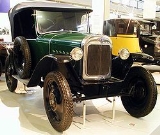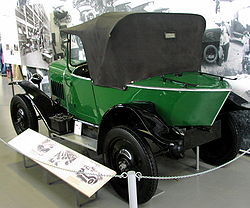
Opel Laubfrosch
Encyclopedia

Opel
Adam Opel AG, generally shortened to Opel, is a German automobile company founded by Adam Opel in 1862. Opel has been building automobiles since 1899, and became an Aktiengesellschaft in 1929...
, early in 1924. Subsequently, various versions of the little Laubfrosch were produced until it was replaced by the Opel 1.2 litre, itself a direct ancestor of the first Opel Kadett
Opel Kadett
The Opel Kadett is a small family car produced by the German automobile manufacturer Opel between 1937 and 1940, and then again from 1962 until 1991 , when it was replaced by the Opel Astra.-Original model :...
, in 1931.
Initially introduced as the Opel 4/12 PS, and manufactured at Opel’s Rüsselsheim
Rüsselsheim
Rüsselsheim is the largest town in the Groß-Gerau district in the Rhein-Main region of Germany. It is one of seven special status towns in Hesse and is located on the Main, only a few kilometres from its mouth in Mainz. The suburbs of Bauschheim and Königstädten are included in Rüsselsheim...
plant, this was the first German car to be assembled on a Ford
Henry Ford
Henry Ford was an American industrialist, the founder of the Ford Motor Company, and sponsor of the development of the assembly line technique of mass production. His introduction of the Model T automobile revolutionized transportation and American industry...
inspired production
Mass production
Mass production is the production of large amounts of standardized products, including and especially on assembly lines...
line
Production line
A production line is a set of sequential operations established in a factory whereby materials are put through a refining process to produce an end-product that is suitable for onward consumption; or components are assembled to make a finished article....
. It was aimed at the lower end of the German auto market, and clearly intended, by the standards of the day, for volume production: it sold well, with approximately 120,000 produced by 1931.
The name
The official name referred to the fact that the car’s engine size gave it a fiscal horse powerTax horsepower
The tax horsepower or taxable horsepower was an early system by which taxation rates for automobiles were reckoned in some European countries, such as Britain, Belgium, Germany, France, and Italy; some US states like Illinois charged license plate purchase and renewal fees for passenger...
of 4 PS (4 hp).
The origins of the Laubfrosch soubriquet are not entirely clear, but may refer to the fact that the cars were normally painted green, which by tradition is a lucky colour in Germany. Emphasis on the colour also served to differentiate the car from the Citroën 5 CV
Citroën Type C
The Citroën Type C was a light car made by the French Citroën car company between 1922 and 1926 with almost 81,000 units being made. The car was originally called the Type C but was updated to the C2 in 1924 which was in turn superseded by the slightly longer C3 in 1925...
which normally turned up painted yellow and was accordingly sometimes known as the Petit Citron (little lemon).
Chronology
The 4/12 PS was produced till 1926. Other variants were the 4/14 PS produced between 1924 and 1925, the 4/16 PS between 1925 and 1926, the 4/16 PS and 4/18 PS between 1926 and 1930 and finally the 4/20 PS, also known as the 1.1 litre, produced between 1929 and 1931.At launch only the two seater open topped Laubfrosch was sold. This had its rear end reworked in 1925. Already, from November 1924, an open topped three seater was available and 1925 saw the arrival of an open topped four seater. From November 1924 the three and (from 1925) four seater models were also produced with permanent fixed roofs. A delivery van version with a door at the back turned up in November 1924. Further variations on the Laubfrosch appeared later in the decade.
Commercial
The 4 PS ushered in Germany's age of mass motorisation, and was attractively priced on launch at 4,500 MarksGerman rentenmark
The Rentenmark was a currency issued on 15 November 1923 to stop the hyperinflation of 1922 and 1923 in Germany. It was subdivided into 100 Rentenpfennig.-History:...
. By 1930 Opel had produced 100,000 of these cars: initial investment costs had presumably by now been amortized, since the selling price had come down to 1,990 Marks
German reichsmark
The Reichsmark was the currency in Germany from 1924 until June 20, 1948. The Reichsmark was subdivided into 100 Reichspfennig.-History:...
. This was a deflationary period for the major European economies, but even in real money
Inflation adjustment
Inflation adjustment is the process of adjusting economic indicators and the prices of goods and services from different time periods to the same price level. To adjust for inflation, an indicator is divided by the inflation index...
terms, the Laubfrosch became substantially cheaper during its production run. Germany’s first mass produced car could be priced to sell in the volumes that had, by 1930, established Opel, as Germany’s leading volume auto producer. It is almost certainly because of the car's success and the state of the art production facilities at Rüsselsheim
Rüsselsheim
Rüsselsheim is the largest town in the Groß-Gerau district in the Rhein-Main region of Germany. It is one of seven special status towns in Hesse and is located on the Main, only a few kilometres from its mouth in Mainz. The suburbs of Bauschheim and Königstädten are included in Rüsselsheim...
that in 1929 General Motors
General Motors
General Motors Company , commonly known as GM, formerly incorporated as General Motors Corporation, is an American multinational automotive corporation headquartered in Detroit, Michigan and the world's second-largest automaker in 2010...
purchased an 80% holding (subsequently increased to 100%) in the Opel family's auto business.
Plagiarism is alleged
Opel’s Rüsselsheim plant may have contained the first automobile production line assembly system in Germany, but the first automobile production line in Europe had been created by André CitroënAndré Citroën
André-Gustave Citroën was a French industrialist. He is remembered chiefly for the make of car named after him, but also for his application of double helical gears.- Life and career :...
who had initially adopted Henry Ford’s system for the production of munitions, and subsequently applied the technique to production of the Citroën Type A
Citroën Type A
The Citroën Type A was the first car produced by Citroën from June 1919 to December 1921 in Paris. The Type A reached a production number of 24,093 vehicles.During World War I, André Citroën was producing munitions...
. It was not merely the production system that Opel took from Citroën. The two seater Opel 4 PS when launched in 1924 bore an uncanny resemblance to the little Torpedo
Torpedo (car)
The torpedo body style was a type of automobile body used from the early twentieth century until the mid-1930s, and which fell quickly into disuse by the Second World War....
bodied Citroën 5 CV
Citroën Type C
The Citroën Type C was a light car made by the French Citroën car company between 1922 and 1926 with almost 81,000 units being made. The car was originally called the Type C but was updated to the C2 in 1924 which was in turn superseded by the slightly longer C3 in 1925...
which had been launched in 1921. Sources differ as to whether Opel purchased the right to assemble the Citroën under licence, or merely copied the design.
There were differences. The Opel’s wheelbase was longer by 5 mm and the look of its radiator was different. The early Opels were mostly green whereas the early Citroëns were mostly yellow. Under the skin, the Opel had a twelve volt electrical system at a time when most cars (including the Citroën 5 CV) used a six volt system. And the Opel’s four cylinder water cooled engine size was larger, at 951 cc, than the Citroën’s 856 cc. André Citroën
André Citroën
André-Gustave Citroën was a French industrialist. He is remembered chiefly for the make of car named after him, but also for his application of double helical gears.- Life and career :...
nonetheless felt justified in launching a legal action against Opel, and it is not immediately clear just how Opel successfully defended their position.

